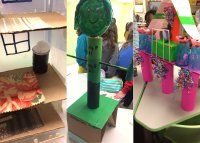Using a Makerspace for English and Humanities Instruction
Turning abstract concepts like symbolism and imagery into 3D representations develops deeper understanding and engagement.
Encouraging an innovative mindset in students is important because the jobs they will have in the future may not yet exist today. Therefore, schools are increasingly asking for funds for 3D printers, robotics arenas, and makerspaces. While these shiny new tools are typically reserved for the STEM fields, English and humanities teachers can use a school’s makerspace to build on content.
Printing a Symbol
Teaching symbolism can be difficult. To help my students realize that symbols are tangible objects and not simply ideas, I have them print a symbol from a book using a 3D printer and then explain the symbolism behind the item using the book’s context. Even without a 3D printer, students can create symbols that relate to specific in-class texts. Keeping the symbols in the classroom all year—to remind students of common archetypes—is a way to connect makerspace work with larger ideas in the English classroom.
For example, a group of students was reading The Giver. After learning about symbolism, they were asked to pick a symbol from the book, print it, and explain it to others. I thought they might simply print an apple and move on, but one group decided to use some additional art supplies to shade in half of the object with gray chalk, representing the time before the main character was able to see color. The other half of the apple was red. They explained how the apple symbolized a transformation within the protagonist as he matured and received information in his role as the receiver of memories. The three-dimensional nature of the project allowed for greater creativity and more nuanced understanding of symbolism.
There are readily available 3D designs on Thingiverse. Other classes have designed their own objects using Tinkercad, a free, robust learning platform that helps students understand how to use the interface, move objects around on a 3D plane, and combine shapes. Most of my students ease into designing after spending 20 minutes with the programs.
Create a Monument or Memorial
After students read different books on a specific time period, I asked them to select a person or group of people that stood out to them from the unit. They then needed to create an “architectural mock-up” of a monument or memorial to the person or group in a smaller, to-scale size.
In some cases, students needed to complete additional research in order to gather enough information so that the monument could be completed with a proposed site, background, and personal narrative attached to it.
Students worked on this in the school’s makerspace, using recycled materials to build their scenes. This isn’t a 1990s diorama, though; students had to work together to reinvent paper clips, pizza boxes, egg cartons, and buttons as parts of a memorial. What could be used to make a ladder? A bed? A makerspace usually won’t have these objects assembled already, so it’s up to each student’s creativity to build it from other materials.
By working collaboratively and creatively, students combined multiple skills in the English classroom in order to complete the task. The physical monument needed to be related to the unit and clearly understood. Their written statements were concise and accurate. The experience provided an opportunity for the strengths of individual students to work together as they taught each other how to use tools, look at objects a new way, or problem-solve through challenges. In the end, students were able to use others’ work to expand their own thinking on the topic.
Build Writing
While I sometimes use exit slips, fast writes, and other formative assessments to check for understanding, I decided to ask for a different type of writing assessment. I asked students to show me their understanding of what makes a good piece of formal writing by building it: How does it connect? What pieces are present? What is necessary, and what might just get in the way?
Most students could explain that an essay needs a thesis, support, transition words, and a strong conclusion, but they had to think about what materials to use and how to connect the pieces. Some had a clear center of their structure—all other pieces revolving around it like the sun in our solar system—while others were more linear with a house-like top-down model. I loved seeing their creative takeaways near the end of the year when they were more likely to groan with the assignment of another essay. I was able to formatively assess just what they had grasped from the year and what I needed to reteach before the end of school. For example, if every group in a class focused on thesis statements but omitted textual evidence, I knew to review that part of the essay with them.
Initially, the goal of taking the class to the makerspace was to get them thinking about English in a new light, but the gains went beyond reading and writing. Students built long-term skills through design thinking. They problem-solved to determine exactly which tools produced the results they wanted. Students built on others’ strengths and knowledge to create a final product, usually after a few changes in plans. The collaborative work in the makerspace gave them the freedom to determine their next steps.
